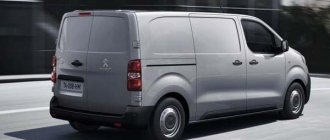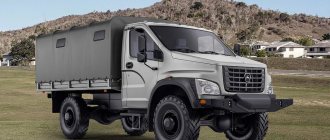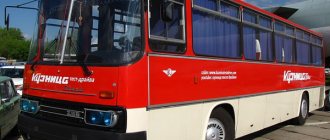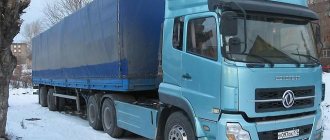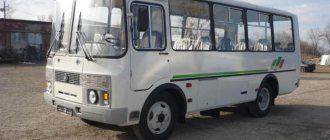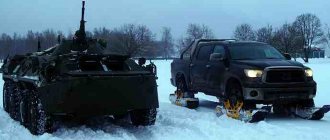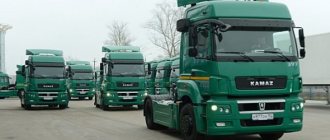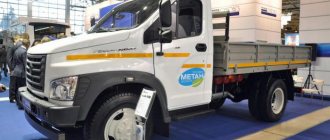First impressions
We came to meet the representative of the Mighty EX8 at the official TTM Center dealer in Domodedovo, Moscow Region. Here a chassis with a refrigerated superstructure was waiting for us. Unlike the previous HD series, there is a new cabin, power unit, frame, side members, air filter... However, we will get to that later, but for now we will inspect the truck.
The first difference is that instead of the rounded shape of the HD78 cabin, we have a more strict rectangular one, like many Korean cars. The question of susceptibility to corrosion immediately arises. Denis Kobets, senior product manager at Hyundai Truck and Bus Rus LLC, says that, firstly, the cabin is subjected to anti-corrosion treatment, and secondly, the thickness of the paint layer reaches 100 microns, so if rust appears here, it will not be very soon .
Tester: Denis Kobets, senior product manager at Hyundai Truck and Bus Rus LLC
“We also developed a new system to reduce noise in the form of rubber seals on both the door and the cabin, unlike, for example, Isuzu, where they are present only on the door. For comfort, we also install in the basic configuration a sprung seat with adjustable hardness and softness, as well as heating. This was a request from clients.
The width of the cabin is 2 meters, and the internal volume is 3.5 cubic meters, thereby allowing you to relax with great comfort; we also have a chair with lumbar support and an armrest as standard. If the driver needs to rest a little, he can fold the handbrake without fear that the car will roll away,” explains Mr. Kobets.
A two-stage air filter was placed behind the cabin on the right side. Preliminary cleaning of the air duct from large particles can be done by simply pressing on the rubber seal. There is also an expansion tank for coolant nearby. Next on the frame is one 12 V battery. However, the battery is not completely closed, so moisture and dirt can get into the terminals. But as for the wiring and connectors running inside the frame, everything is insulated with corrugations and covered with plastic connections. We have already seen this in JAC trucks after they were carefully adapted for use in Russia. Isuzu is still lagging behind in this regard.
On the left side of the frame there is a fuel filter and a 150-liter tank. By the way, versions with a short wheelbase have a 100-liter capacity. The spare tire is located in the rear overhang as standard.
Another important difference between the Hyundai Mighty EX8 and many Euro-5 class cars is the absence of an AdBlue tank and a particulate filter. The designers achieved compliance with environmental standards by installing a PMC filter.
“It’s not really a particulate filter. Everyone usually uses a DPF with a ceramic base and a burning system. DPS has honeycombs inside, they are closed, and when soot becomes clogged, the machine injects fuel into it to burn it. But here it’s different - a metal base is used, the honeycombs remain open, and the soot falling on these plates is immediately neutralized and is not so harmful,” says Denis Kobets.
Daytime running lights and fog lights are standard. Unfortunately, ordinary halogen light bulbs were used in optics. The manufacturer is looking for a supplier of domestic LED analogues, but with plans to produce up to 2000 cars per year, large factories cost 2 times higher than flashlights produced in Korea.
Well, it's time to go inside and see how comfortable the driver's workplace is. We immediately notice that even the steps are closed with a door, like in reputable European truck tractors. Of course, you can’t leave your shoes here, the area is not the same, but there will be no more dirt - there won’t be any streaks on your pants.
On the track
Test runs on the 4x2 truck tractors provided to us were limited to checking the functionality of the safety systems and driver assistants. In particular, a system for keeping the truck in its lane was tested. However, it was only possible to test the functionality of the system on a racing track on the third attempt.
We tried adaptive cruise control with the help of a passenger car in front: no problems there. The tractor braked behind the slowing car, keeping a safe distance.
It makes no sense to talk about acceleration dynamics, engine braking, clarity of gear shifting in the box, smoothness of movement in relation to the “head”. Fortunately, all this was appreciated during a full test drive in Spain. So, in general, we can wish TGX one thing: good luck, “lionheart”!
In anticipation of the test drive, the event organizers prepared an excursion to the production site of Truck Production RUS, a unique enterprise in St. Petersburg, where heavy MAN and Scania trucks (both brands are part of the Traton group) are assembled on the same production line. Since February, the stage-by-stage assembly of the new generation TGX trucks has begun here. After the July holidays, the company will completely switch to the production of new cars.
Transport became the owner of the first four MAN TGX trucks of the new generation. The delivered vehicles are equipped with an engine of Euro-5 environmental standard, a MAN TipMatic 12.26 DD gearbox with the MAN EfficientRoll function, which allows you to maintain inertia on road sections with different terrain and save more fuel, as well as Idle Speed Driving, which ensures comfortable idling. go.
About operation
The driver's seat is really comfortable. Can be adjusted according to height and weight. You can also adjust the position of the steering column. We insert the key, the dashboard responds with soft lighting. In addition to readings about speed, engine speed, fuel level, you can view data from the on-board computer.
For driver convenience, there is a multifunction steering wheel with stereo control, stereo control (1-DIN from Korea), speakerphone when connecting a smartphone and cruise control. To be fair, we note that the sound of the Korean standard audio system is excellent, even while driving down the street it pleases the ear. According to a representative of Hyudai Truck & Bus, production vehicles are already equipped with a 2-DIN touch screen multimedia system (from China) equipped with a rear view camera as standard.
There is a niche for a 1.5-liter bottle, 2 hooks for clothes, a bunch of niches for documents, and the back of the middle seat transforms into a table. But climate control is not provided; air conditioning is optional. But the basic configuration includes electric windows and heated rear-view mirrors with electric adjustment. The windshield offers a good view, but the side pillars are still a bit thick - there are “blind” spots when turning. On the plus side, we also note that the nozzles for washer fluid are located directly on the wipers, so there will be no unnecessary splashing.
But the presence of glass on the back wall will increase heat loss in winter. In the absence of full climate control, the driver will have to run the heater at maximum, frying his legs, face and hands.
“Yes, we sell 60-70% of cars with isothermal vans, but there are also others - a tow truck with a sliding platform, flatbed platforms + CMU - and with these types of add-ons, a rear window and a central rear-view mirror are required. What's the nuance? Competitor Isuzu supplies cars with a closed side and without a center mirror, but if they install a tow truck or flatbed + CMU, this car will be inconvenient to operate. But Isuzu cannot install a rear window and a mirror in the cabin, since it is not certified. And especially for non-van consumers, we supply the market with cabins with glass and a central mirror,” explains Denis Kobets.
Heat loss, of course, will be smoothed out by heating the seat. But this option is only available for the driver. The forwarder will freeze. Although, again, according to manufacturer research, 80% of consumers drive alone. The remaining 20% should dress warmer.
Meanwhile, we have already warmed up the engine and are ready to move. Moreover, unlike numerous past truck tests, this time we will not drive empty, but loaded. The van contains 2.4 tons of sand in bags. This, of course, is not even half the officially permissible load, but it’s better than nothing.
“The front axle can withstand 3100 kg, the rear axle - 6400 kg, and I’ll say right away that this car was made before April 1. Unfortunately, before this date its total mass was 7800 kg, then we raised it to 7990 kg. Owners of old cars can contact the supplier and reissue the title with a higher gross weight. The chassis has a total weight according to the protocols of 8200 kg, but we have not yet raised it to this value due to the disposal fee, because there is a separate rate for 8 tons or more.
The total technically permissible axle load is 9500 kg. The machine is certified for use with a trailer, up to three and a half tons. That is, 8 tons plus 3500 kg, this will already be 11.5 tons,” Denis winks.
Knowing the love of carriers to load more and carry further, the designers also worked on the frame design. If in the Hyundai HD78 it was bottle-shaped, then in the Mighty EX8 the spars were made straight, 6 mm thick. The height was increased from 197 mm to 216 mm, and the width to 7 mm. The machine has become not only more durable in terms of carrying capacity, but also more stable.
While they are telling us about the new chassis frame, we are already confidently rolling down the road. The load in the van is not even felt - the Hyundai Mighty EX8 easily starts from second gear. The engine, by the way, is not the same as in the HD78 or EX9. Under the cabin growls its own Korean D4CC chain with a volume of 2.9 liters and a power of 160 hp. With. Engineers worked on the creation of the engine for almost 5 years, and thanks to the new Garrett turbocharger with variable geometry, the torque is 392 Nm.
The head is cast from aluminum, and the cylinder block is cast iron. Inside there are Denso injectors.
The internal combustion engine was coupled with its own 5-speed gearbox. It is the same as on the HD78 Euro-4.
There is an ActiveEco mode; when activated from the button, the increase in torque slows down, which saves fuel. True, provided that the car is moving on a flat road, not uphill, and the driver does not press his slippers to the floor.
When driving on asphalt, the suspension is soft. Although it has springs, it has gas shock absorbers. The cabin is mounted on rubber seals, so the ride is quite comfortable. Anti-roll bars are present. I was also pleased with the anti-recoil system when lifting. Your humble servant had the negligence to park the truck on a slope when entering the road from the adjacent territory and, allowing the flow of traffic to pass, did not have time to depress the clutch in time to change gear. It was the start-up assistance system that saved me from fatally rolling back. Fortunately, the braking system, although drum-based, is very effective.
Large cargo test drive
/15.01.15/
Recently, test drives of cars have become part of my work. Over the past two years, from personal experience, I have been able to test more trucks than in my entire time as a driver. At the same time, I read in the comments that the review was not informative, there was little data and technical documentation. Comments, often quite justified, I always take them into account and try not to repeat mistakes. Today I would like to talk about what a truck test drive should ideally be like.
What made me sit down to write this material was an article published in the German magazine Lasauto Omnibus. It was written based on the results of a curious test, which was initiated by. For this purpose, seven tractors from leading European manufacturers were purchased, with almost identical technical characteristics. The company took an unprecedented step in order to find out which of the Big Seven trucks is the most profitable.
The test drive lasted for three years, these were tractors: DAF XF, Volvo FH, MAN TGA, Scania R, Mercedes-Benz Actros, IVECO Stralis and Renault Premium. The equipment of the trucks was extremely identical: engines with power from 400 to 420 hp, 6x2 wheel arrangement, automatic transmission. As part of a road train, the vehicles worked on the line and drove more than 300,000 kilometers, driven by the best drivers of the enterprise. All brands were initially placed in absolutely identical conditions, which is practically impossible for any publication, journalist, and even more so blogger.
We also do not forget that business optimization calculations for a private entrepreneur and for a large company are very different. If a single private owner in most cases is his own driver, mechanic and accountant, then in a large company all roles are strictly divided and each link in the chain is engaged only in its own business. Where a private owner can stand idle for another week without any consequences, for a company even a day of downtime will result in major losses. Therefore, the main assessment and criterion of the big test was branded service and downtime associated with repairs.
The results shocked all participants and became a pleasant surprise for the winner.
Here’s what company director Jochim Fehrenkötter said upon completion: “Any result was important to us. We organized such a test to establish which truck would be an alternative for our fleet in real conditions. Renault Premium has proven to be a champion in terms of cost reduction; It has the lowest running costs and its fuel consumption figures are excellent.” Operating cost test results*
* All data provided by Fehrenkötter. Average fuel and AdBlue consumption is calculated after refueling. Expenses due to mechanical damage were not included in the cost of operation.
The test drive itself is very interesting, if anyone speaks German, here is a link to the original article. However, in order to draw some conclusions, I will give the result of another not too serious test I conducted in my spare time. In good weather, I tossed the coin a hundred times in a row, it came up heads 48 times, then the weather turned bad, but I tossed the coin again, this time it came up heads 52 times. Statistics show that bad weather increases the chance of landing heads by as much as 4%. But is this really so, think about it?
Any test is an experiment under certain conditions, and to be reliable it must be long-lasting and versatile. The vast majority simply cannot afford such troubles, so many programs, articles and reviews are nothing more than a personal opinion and an attempt to present the viewer with a particular car from their own point of view.
Verdict
If we discard comparisons with the previous HD78 model, then from modern analogues we get a completely worthy competitor. Richer in basic equipment than its closest analogue from Isuzu and, importantly, more affordable in financial terms. Yes, of course, there is a cheaper offer on the market in the form of GAZ Valdai Next, but it has a Cummins ISF 2.8. And considering that the compressors for pneumatics and air conditioning are powered from it, the engine power begins to lose to the Korean D4CC. And if you put a refrigerator there, the engine will generally become very weak and ineffective.
In terms of average fuel consumption, the Hyundai Mighty EX8 shows good results. According to telematics data, a car traveling 400-500 km per day with the temperature in the van maintained at -15 ° C and an average speed of 60-70 km/h consumes approximately 14-15 liters per 100 km.

